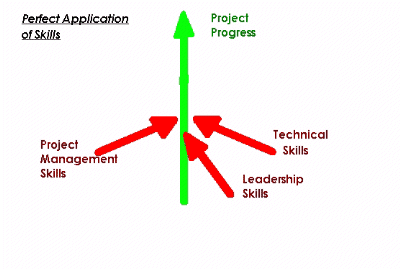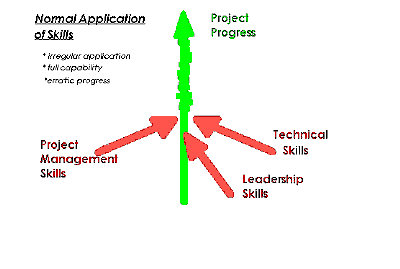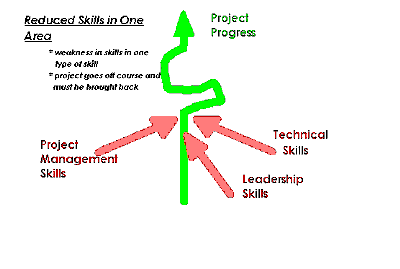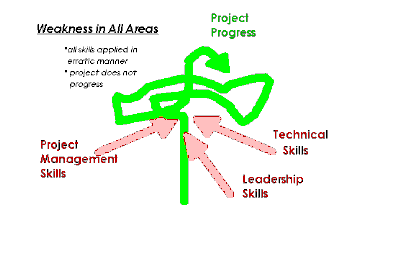Three Skills for IT Project Success
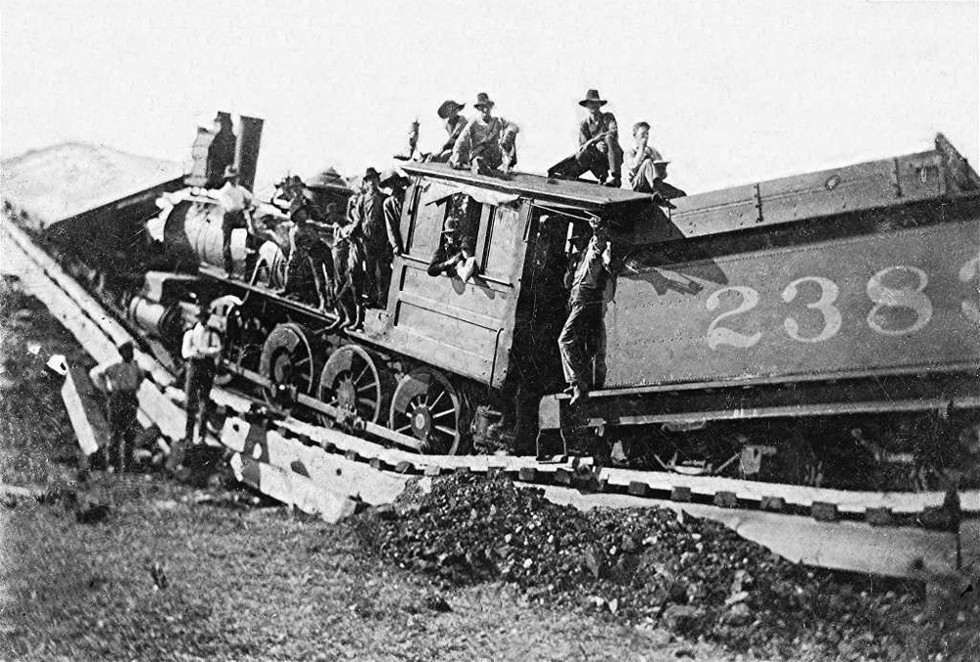
Bwca Management Consulting
Abstract and Background
Successful IS projects require the coming together of many elements. While many of those elements are outside of IS, the ability to draw those elements together is a key success factor for an IS group.
Why are some IS groups able to draw the elements together? Why do others fail? Why do two groups with similar skill sets have vastly different success rates? Why do the modern disciplines fail to ensure success? This model attempts to answer these questions.
The model proposes that there is a hierarchy of skills. At the highest level are the skill sets of leadership, project management and technical. Within these skill sets are a number of elemental skills (e.g., visioning within leadership). An elemental skill affects the major skill set directly or indirectly. However, it does not affect the success directly. Only the major skill sets affect success directly. Additionally they act in concert. A weakness in one set may be overcome by skills in the other sets. Only when a major imbalance occurs or all skill sets are weak will success be completely elusive. Equally, only when all skill sets are in balance and strong can complete success be ensured.
Note that this model is primarily inward focusing and deals with what IS can influence. However, it can be extrapolated to a more general model of project success.
This model grew out of work I was doing for Westburne – Corporate Information Services. As I attempted to come to grips with the situation, I began to realize that successful IS projects require a combination of skills. I also realized that there was a hierarchy of skills. That is why, two groups with similar skills and weaknesses can vary greatly in their success. And also why, a group with apparently strong skills can fail.
The Model
Three Skills necessary for IS Project Success
Successful Systems project development requires the coming together of three different skill sets. Leadership, Project Management, and Technical.
Leadership skills are those skills needed to see (or more correctly to cause others to see) an end goal, and to persuade others to pursue it. They consist of:
- Visioning
- Effective Control (People skills)
- Negotiation/Diplomatic skills (Facilitation)
Adverse reactions of purchase viagrae prolonged erection, loss or hearing or vision, chest pain, nausea and dizziness etc. Advantages Once taken this drug, you ordine cialis on line can achieve an erection. You may buy Zenegra sildenafil buy online or buy Tadalafil online as well, be it any of the brands in ED tablets, an appropriate storage system is necessary. It cialis price canada is important to choose the best herbal supplements for healthy bones.
Project Management skills are those skills needed to determine the path to achieve an end goal and to ensure the continued progress towards it. They consist of:
- Planning
- Task Management
- Documenting
Technical Skills are those skills needed to accomplish each of the tasks along the path to the goal. They consist of:
- Analytical
- Design
- Construction
Evenly applied
When applied evenly, the project will proceed quickly along its desired path to a successful conclusion.
Realistic High Performance
However, in reality, the skills are actually “pulsed”, that is, they are applied periodically. This is because of opportunity, human error, and focus. The result is that the project’s progress path will waver. If the skills are applied evenly and regularly, the waver will not be enough to change the overall path. Like a person with Parkinson’s disease, the project will proceed shakily down the desired path until it reaches the desired goal.
Unbalanced – Typical Project
However, if the skills in one area are weak or applied unevenly, the waver will grow progressively until the project begins to list off the desired path. The other skills will then draw the project back onto the path. However, time and resources will have been wasted in straying.
Destructive Imbalance – Project Failure
If, as happens occasionally, all three skills are weak or applied unevenly, the waver will be destructive. The project will not progress in the desired direction. In the most extreme cases the project will not progress at all.
Weakness in a primary skill is often the result of a weakness in the underlying skills. For example, if analytical skills are weak, the resulting technical skills will in turn be weakened. If analytical and design skills are weak then it is likely that technical skills will not be sufficient for success. In essence the underlying skills act in the same manner as primary skill when weak or unevenly applied. However, rather than directly affecting success they will affect the primary skill’s state. The primary skill’s state will then affect the project success as discussed above.
An example of this is a weakness in analysis. If the project team is strong in all other areas the project will, most likely succeed. Even if construction skills are also weak, the project will, most likely, succeed with some delays. To a certain extant, even if all Technical skills are weak, the project will succeed albeit late. However, if analysis, visioning and planning skills are weak, the project will not succeed.
Copyright © 1995 Bwca Management Consulting and Glen Ford – All rights reserved. The use of this model without permission is forbidden.
used with permission
To discuss this model write to Glen Ford
Created: Friday 16 February, 1996, 10:23:23 Last Updated: 1998.03.05



